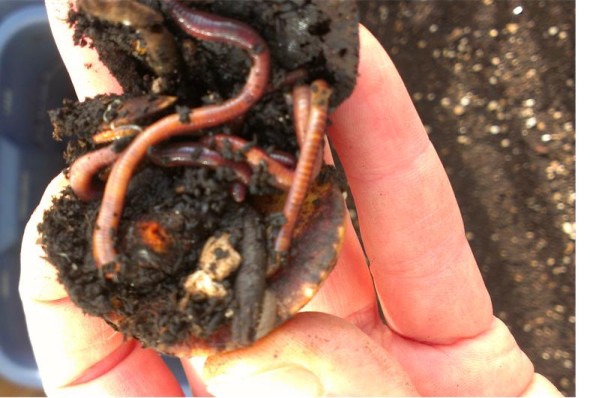
By Jennifer Clark–
We’ve probably all put a worm on a hook to catch a fish at some point in our lives—maybe, like me, it was when you were out fishing with your grandfather as a kid. What I never knew until I started to learn about urban gardening and sustainability was that those wiggly worms you can buy for fish bait can be so much more useful to you alive for composting food waste in your kitchen. Like my mother did at first, you might say, “Ew, gross, worms in my kitchen?!” My answer to that is, “Absolutely!”
Worm composting systems are easy to set up, low maintenance, and interesting. If you have limited, or no outdoor space (for instance, if you live in a condo or apartment) or are concerned about possibly attracting animals with an outdoor compost, a worm compost bin could be the answer. This method of composting is also a great companion to small-space gardening on balconies, or even having a traditional garden in your backyard.
Worm composting recycles organic matter like food scraps or animal waste into a nutrient rich substance called “worm castings” which can be used as a soil additive to improve soil fertility, texture, and water retention. Unlike traditional composting that you might do outdoors in a compost pile, worm composting is always aerobic (takes place in the presence of oxygen), and low-temperature. Traditional composting relies in part on anaerobic (oxygen-free) fermentation, which increases the temperature in the composting waste—it “cooks” the materials, helping them to break down. Worm composting, on the other hand, keeps the temperatures low and relies on the activity of the worms, which consume the food scraps or other materials and excrete castings, which are nutrient-rich and easy to use as a soil amendment. Worm composting can be done on a massive, industrial scale, or, in a small bin within your own kitchen.
Worm composting is generally more rapid than traditional composting, producing usable compost, or castings, within three months of starting your bin. (Insert image 1 here) It is also more compact and can be done indoors, which makes it great for people living in apartments or rentals with no yard access. It is generally odourless, and pretty trouble-free. (I have kept two worm compost bins under my kitchen counter for more than six years now without any problems at all.)
Generally, there are two closely-related species of earthworms that are used in vermicomposting or worm composting: Enseiniafetida and Enseiniaandrei. E. andrei is currently considered the most productive of the two species, but either can do the job. These earthworms tend to be small, striped, red with yellow tails, and very active, hence their common name, “Red Wigglers.” When disturbed, they tend to thrash around and wiggle a lot. At first you might feel a little squeamish about your new earthworm community, but once you get used to them, you’ll realize that they are a great asset to your household, and that they are totally harmless for you to handle. Most kids love helping to take care of a worm compost bin, making it an excellent educational opportunity for kids to learn basic biology and sustainability principles.

Why start a worm compost bin?
- It’s easy and faster than traditional composting, taking up to just three months to produce usable compost.
- You can have a worm compost bin anywhere, even inside your apartment or house because it’s compact, and generally odourless.
- The compost, or castings, your worms produce can be used in your garden or potted plants to grow bigger, more plentiful veggies, greener, healthier lawns, and lush, beautiful plants. They also restore beneficial microorganisms to your soil.
- Composting your food scraps helps the environment by keeping your food scraps out of the landfill and reduces the waste produced by your household.
- Keeping food scraps out of your garbage bin reduces odour and mess in your garbage, reducing the risk of attracting animals like bears, rodents, or raccoons.
- It’s fun and educational—a great way to teach your kids about composting.
If you’d like to start a worm compost in your home, there are resources available to you right here in Williams Lake. A worm compost bin can be as fancy or as simple as you wish to make it. I started my compost in two, small, Rubbermaid tubs with holes cut into them for air circulation and drainage, and still use them—this is likely the least expensive option, but it is not necessarily as rapid as using a purpose-built worm composting bin.
Red Wiggler worms and purpose-built worm composting bins can be purchased from the Cariboo Chilcotin Conservation Society, which can be contacted at (250) 398-7929. The Conservation Society is also considering offering worm composting workshops to help you get started. If this is something you’d be interested in, please let the staff know. Information on basic worm composting is also plentiful on the Internet, including some of the sites listed below.
Jennifer Clark grew up as a part of the fourth generation on a family horse and cattle ranch in the East Kootenays, moving from the ranch to a small hobby farm at the age of 12. She has studied sustainability issues and urban planning at Selkirk College in Castlegar, BC and the University of British Columbia in Vancouver, before moving to the Cariboo. She was a wildland firefighter for eight years, is a fanatical gardener, and has worked and taught urban gardening at garden nurseries in Vancouver and for several non-profit organizations. Jennifer is also an experienced potter who is involved with the Cariboo Potters Guild, occasionally teaching beginners’ classes at the guild studio. On a nice day, she can be found anywhere outside, gardening, hiking, or if she’s really lucky, kayaking in a borrowed kayak.
